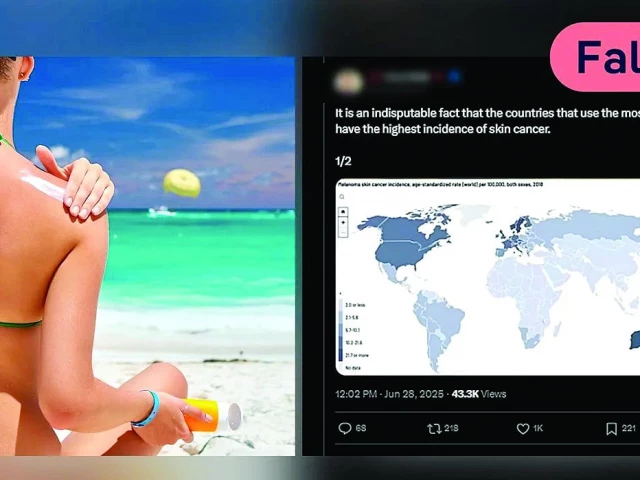No, sunscreen will not give you skin cancer
Experts refute viral claims about melanoma

Posts on social media have popped up recently, claiming that applying sunscreen reportedly increases the risk of skin cancer. Even though ultraviolet (UV) radiation is the main cause of melanomas, and sunscreen helps protect skin by filtering UV rays, these posts claim that sunscreen itself is doing damage, as reported by DW.
"It is an indisputable fact that the countries that use the most sunscreen, have the highest incidence of skin cancer," said this X user in a post with close to 60,000 followers. "And the more sunscreen they use, the greater the prevalence." There are also TikTok videos warning about sunscreen.
"There is no scientific evidence that supports the association of sunscreen use with a higher risk of cancer," Brittany Schaefer, Public Information Officer with the Connecticut State Department of Public Health told DW.
The X post attributed the chart to the Connecticut Tumor Registry (CTR), but Schaefer says that was inaccurate.
"The original cancer incidence data likely came from the CT Tumor Registry decades ago, but not the added text boxes regarding sunscreens. We do not know the source of the actual graphic, but it was not from CTR or the Connecticut Department of Public Health," she said.
But why is the number of global skin cancer cases on the rise, even though more and more people are using sunscreen? A study across several countries from December 2023involving scientists from the US, Switzerland, Germany and Hungary looked at five hypotheses to get to the bottom of this.
According to the study, possible reasons for misunderstandings and myths around linking skin cancer risk and sun protection include access to better diagnostics and treatment methods, outdated scientific studies, erratic use of sunscreen and climate change.
Global incidence rates
Rising awareness about skin cancer risks among both patients and doctors has led to an increase in reporting and documenting cases. In contrast to higher skin cancer incidence worldwide, the mortality rate has dropped due to better treatment options, says the World Health Organisation's International Agency for Research on Cancer.
According to the World Cancer Research Fund, Australia had the highest age-standardised incidence rate of new cases in 2022: 37 new skin cancer cases per 100,000 people per year, followed by Denmark (31.1), Norway (30.6), New Zealand (29.8) and Sweden (27.4).
The US ranked first with 101,388 cases in terms of the total number of skin cancer cases in 2022, while Germany ranked second with 21,976 skin cancer cases, with an identical incidence rate of 16.5.
In terms of the number of skin cancer deaths in 2022, the US again took the lead with 7,368 deaths, while Germany ranked fourth with 3,303 cases, behind China and Russia. The following graph also shows that a high incidence rate of skin cancer does not necessarily correspond to a higher mortality rate.
Another reason for rising skin cancer rates could also be the fact that people spend more time outside in the sun. Even if they applied sunscreen, that was no guarantee that they used it as intended to protect their skin.
The lack of current scientific studies further adds to the problem of reinforcing outdated narratives. The US Food and Drug Administration (FDA) only began regulating sunscreen in 2011. All prior studies examining sunscreen use and the development of melanoma were likely conducted with products that did not offer the same level of protection as those currently on the market.





















COMMENTS
Comments are moderated and generally will be posted if they are on-topic and not abusive.
For more information, please see our Comments FAQ